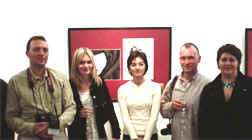 I went into the Exhibition Hall at the Faculty of Art, Design and Architecture
and had a chance to look around before the exhibition’s curator, Edyta Michalska,
greeted me warmly. It was the opening night of "Pastiche. Mona Lisa With A
Smile." It soon became clear that I had entered a world of skewed photographic
visions, and I wanted to know more! I went into the Exhibition Hall at the Faculty of Art, Design and Architecture
and had a chance to look around before the exhibition’s curator, Edyta Michalska,
greeted me warmly. It was the opening night of "Pastiche. Mona Lisa With A
Smile." It soon became clear that I had entered a world of skewed photographic
visions, and I wanted to know more!
I wanted to find out who did these things and, more importantly, what these things were!
As it turns out, the photographs were part of an assignment given to a group of Polish
students in a seminar called, "The Arts Interpenetrating," led by Pawet
Borkowski, with the cooperation of Stefan Figlarowicz and Krzysztof Jakubowski. These
seminars are similar to an open university. This was a place where children, teens and
adults could experience and learn. This was a place where the age and gender gap was
diminished.1
The end products of the seminar were hung on the walls, land looked quite interesting
indeed. Classical art works had been reorganized and reinterpreted from a most unique
point of view, using the camera instead of the canvas. Pawet Borkowski, who works as a
photography teacher in a middle school, took some time to introduce me to the artists. To
them, it seemed that photography was not just a hobby, but a passion.
One of the artists shared with me that she preferred to work specifically on portraits of
women. When I asked the reason, she stated that women are very interesting. She then
clarifies that Polish women are especially interesting. She further clarified, saying that
she had also seen some very interesting women in Turkey. During the “Pastiche”
sessions, where she tackled the classic "Two Women Drinking," she explained
about how her and her subjects had a really good time with the entire process, and the
photo shoots were lot of fun.
Also on hand for the grand opening was the curator of the Photography Department at the
National Museums in Gdansk. The school these artists attend often cooperates with the
National Museums. I had an opportunity to speak with her and get a little more insight on
what the school these artists attended was all about. She enthused that it is a fantastic
place for anyone with an interest to learn more about photography, culture and art. She
also added that it offers good opportunities to intermingle with people of various
backgrounds who may not ordinarily cross paths. This group of artists have been working
together, and have gone on trips to take photographs. They have created bonds,
communicated, and shared experiences and ideas.
It was true; all of the photographers come from an interesting array of professions. One
artist is in the communications field, another is an electronic engineer, while another is
a graphic designer. Regardless of what they do for a living, photography is the one thing
that connects them all, though each artist offers their own interpretations of the world.
I must say that I really enjoyed the photographs and their somewhat mocking perspective.
If you ask me, the way the original paintings were transformed into photographs, and then
reinterpreted in such unique and often comical ways, will stick in my mind for a long time
to come. This exhibit will challenge how viewers have looked at the classics that have
been part of our culture for decades, if not centuries. This is one exhibit that will make
people tilt their heads to the side, stroke their chin with their fingers and say,
"Hmmmm….interesting indeed."
"Pastiche: Mona Lisa with a Moustache," can be seen until October 17 at the
Exhibition Hall of FADA.
1- Leaflet from the exhibition, page 3
By Alev Ýclal Deðim (COMD/III)
 |







